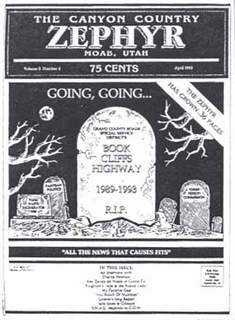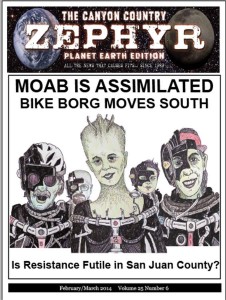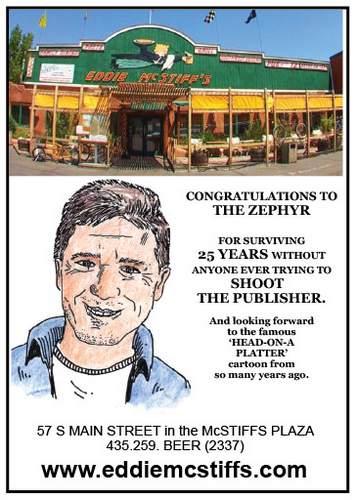In the very first Zephyr, I wrote a long article about a road building proposal that would be debated for years. In late 1989, the lame duck Grand County Commissioners created a self-funded, autonomous special service road district, with the specific goal of building a multi-million dollar, modern, paved highway that would connect Grand County and Moab in the south with Uintah County and Vernal to the north. They called it the ‘Book Cliffs Highway.’ Its purpose was to provide better access for oil and gas development, but the highway was also pitched as a tourist road that would increase recreational traffic and shorten the travel distances.
Elsewhere in this issue you can read a narrative of the battle to stop the road. Opposition was light in the beginning, but by 1992, those of us who opposed the road began to gain some traction. Eventually, a change of government in Grand County and a negative environmental impact statement by the BLM killed the idea. We thought it was dead for good.
 But last week, word came that the Grand County governing body is again pursuing the idea, via a letter to their council-counterparts in Uintah County. The proposed alignment is different this time; instead of following existing dirt and gravel roads on the far eastern end of Grand County, as the plan suggested in 1989, the council wants to create a new ‘transportation corridor’ through Sego Canyon, north from Thompson Springs and I-70.
But last week, word came that the Grand County governing body is again pursuing the idea, via a letter to their council-counterparts in Uintah County. The proposed alignment is different this time; instead of following existing dirt and gravel roads on the far eastern end of Grand County, as the plan suggested in 1989, the council wants to create a new ‘transportation corridor’ through Sego Canyon, north from Thompson Springs and I-70.
Uintah County is flush with money these days. Oil and gas development has boomed in recent years; it has transformed the area and dramatically increased, for better or worse, its population and its tax base. The boom has also put incredible strains on its citizens and its infrastructure. I will always argue that these booms eventually cause more harm than good, but trying to get any politician to admit that, be they from the Left or the Right, is almost impossible. Grand County’s current administration wants some of that boom to come its way.
In a letter to the Uintah Council and approved unanimously by the Grand County Council, chairman Lynn Jackson wrote, “In the spirit of cooperation envisioned by the newly formed Seven County Eastern Utah Economic Development Coalition, and a desire for closer coordination with our adjacent county neighbors, Grand County would like to advise you of a concept we are considering in regard to enhancing access and transportation systems in northern Grand County. We suggest such potential access enhancements could also be of interest to Uintah County.”
But the route the county proposes, through Sego Canyon is—or should be— a dead end for future development and has been for decades, thanks to the Ute Indians. Jackson explains, “In the mid-1980’s the Northern Ute Tribe placed a gate across the route on their boundary to guard against trespass onto their lands by unauthorized hunters and fishermen. Prior to closure this road continued for another 7-8 miles on SITLA lands to an old gas well location.”
Indeed. After a century of seeing their lands defiled and taken away, the Utes said ENOUGH. The gate has been in place for more than three decades. Now Grand County proposes a way around this. The letter continues, “(We) would like to investigate the feasibility of improving transportation in this area between the SITLA block and the I-70/railway corridor, and perhaps additional routes between our counties.”
What they propose is a bypass of sorts. The letter calls for joint feasibility studies that would consider, “upgrading and paving the existing Class B Grand County Sego Canyon route to handle vehicle and truck traffic, and would also look at potential for pipelines. They would also analyze extending this road system through the SITLA land block to connect with existing northern Grand and southern Uintah County road systems.” This linking of north and south would require the construction of a road along an entirely new alignment, a task even more daunting than the 1989 proposal.
Of course, the plan touts the benefits of this ‘transportation corridor,’ as it moves forward to sell the idea to the public. It argues that Grand County residents “could receive substantial economic gain through development on lands in northern Grand County and the Uintah basin, with minimal adverse impacts other than a road.,” by opening access to currently inaccessible SITLA lands, and even tries to link the project to a boost in tourism, claiming it would “provide additional commercial exchange between Grand County and the Uintah Basin of all forms, particularly recreation and tourism.” That sounds so much like 1989, all over again.
Click here to link to the Grand County Council’s letter. Look for “Agenda Item N.” It begins at page 75 in the PDF.
This is all very, very early. I only learned about it a few days ago and the letter itself is just a feeler of sorts, to see if there is a mutual interest in Uintah County. But questions arise..
Blazing a new road altogether, circumventing the Utes land and connecting north and south, would be a serious undertaking. It would also split in half a vast roadless area. If there was ever a parcel of land worthy of wilderness designation, it’s this. But specifically, how many miles of new road would be constructed? And how drastically would the existng road be ‘re-aligned?’
Second, if this road were built and all the economic advantages came with it, what would Grand County do with the money? I mean, whats the point? What is it that Grand County lacks that all this infusion of money would provide? Why do politicians always think that increasing the tax base is a good thing? Do proponents realize how it could transform the area? I’m sure Grand County residents would specifically like to know how the revenues could be used and still allow the county to maintain a semblance of its rural self.
When SITLA first announced the Anadarko lease of more than 100,000 acres, the very state land block Grand County is so eager to exploit, Utah sportsmen were furious. And what about the adjacent Uintah and Ouray Indian Reservation? As noted, the Utes have long considered their land sacred. Have they been consulted by Grand County officials?
See these links:
‘Utah sportsmen outraged by gas, oil leasing on Book Cliffs’
‘Unroaded Book Cliffs spared from leasing — for now ‘
The letter from Grand County says, “Indications are that funding to build and maintain this road could come from developers, not Grand County residents.” But if the oil and gas people can easily transport their product north via existing paved roads, why would they want to pay to build a new road via Sego Canyon to I-70, and submit to fees, so they can go south instead? I can’t see this kind of benevolence from the oil industry. Have they actually expressed an interest in this?
And finally, Jackson’s letter notes that, “Under provisions that could be placed in the Bishop public lands legislation bill, Grand County would be given RS 2477 ownership of the Class B County road in Sego Canyon, along with required widths to accommodate upgrade.”
Is this a trade-off that environmentalists are willing to make? Elsewhere in this issue, Ashley Korenblat of the Utah Outdoor Business Network, offers her support for the Bishop Land Initiative. Is THIS what she and others have in mind? To sacrifice untouched parts of northern Grand County in exchange for recreation-rich lands, protected for their tourist revenues, elsewhere?
Like I said, we stand at the very beginning of this process. But it could be a long and difficult fight, for everyone involved.
A SHORT COMMENT ON ASHLEY KORENBLAT’S ‘REPLY’ TO THE ‘BORG’ STORY
Last issue, I wrote a long essay called “Moab is Assimilated. Bike Borg Moves South…Is Resistance Futile in San Juan County?” The essay included long quotes from Ashley Korenblat’s presentation to the  San Juan County Commission last June. After the story was posted, Ms. Korenblat asked for the chance to reply. We offered her 1500 words and she used 750. But her comments only addressed her support for the Bishop Land Initiative and never addressed anything from the Borg story, and specifically my concerns that the kind of recreation/tourist growth she imagines for San Juan County would do little to address the economic needs of the county’s current population. Though some of her peers in the recreation industry took issue with us, suggesting I’d given Korenblat “a bum rap,” I was pleased to see she apparently had no quarrel with any of the specifics of the Borg story.
San Juan County Commission last June. After the story was posted, Ms. Korenblat asked for the chance to reply. We offered her 1500 words and she used 750. But her comments only addressed her support for the Bishop Land Initiative and never addressed anything from the Borg story, and specifically my concerns that the kind of recreation/tourist growth she imagines for San Juan County would do little to address the economic needs of the county’s current population. Though some of her peers in the recreation industry took issue with us, suggesting I’d given Korenblat “a bum rap,” I was pleased to see she apparently had no quarrel with any of the specifics of the Borg story.
Jim Stiles is Founder and Co-Publisher of the Canyon Country Zephyr.
To read the PDF version of this article, click here.
To comment on this article, scroll to the bottom of the page.
Don’t forget the Zephyr ads! All links are hot!








